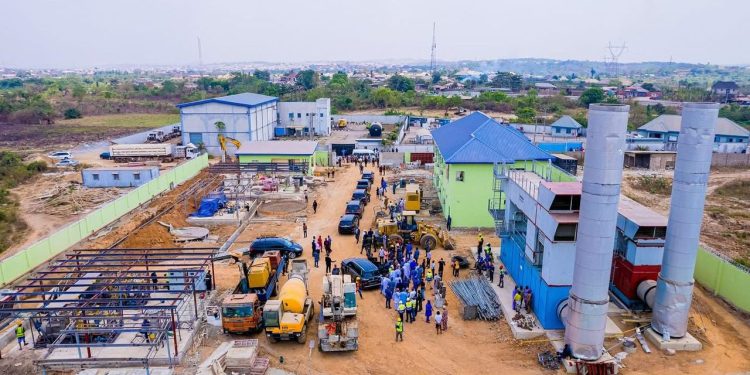Ogun State is on the brink of achieving a significant milestone in its energy sector as Governor Dapo Abiodun recently inspected a new 30MW power plant, signaling progress toward 24-hour electricity supply.
The commissioning of this 30MW plant is expected to enhance the state’s power distribution infrastructure, potentially increasing the percentage of households with reliable electricity. This development could lead to improved economic activities, better quality of life, and attract more investments to Ogun State.This indicates that the majority of households do not receive 24-hour power supply.
Where does Nigeria’s grid electricity come from?
Nigeria’s grid electricity is generated from two sources: Gas and hydroelectric power. Other sources have been explored to generate energy in Nigeria, but only natural gas and hydroelectric have been mainly explored. An estimated 80% and 20% of Nigeria’s grid electricity was generated from natural gas and hydroelectric power respectively. The other sources such as coal, solar, bioenergy, and other fossil fuels are below 1%, according to Statista’s 2023 data.
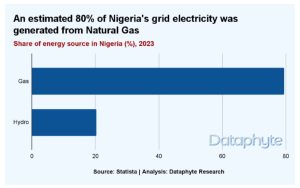
Hydroelectric power is a renewable energy source which uses the power of moving water to produce electricity. In Nigeria, Kanji and Jebba dams are the most significant hydroelectric sources for generating electricity. However, these plants have suffered loss of power generating capacity due to consistent national grid collapses over time. For instance, out of the 28 grids connected to generating plants, only three are performing at an optimal level. Six are operating at an average capacity, while the remaining 19 are in poor condition, according to the Nigerian Electricity Commission.
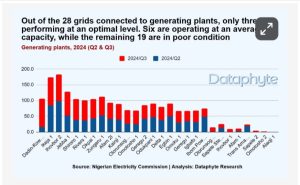
Current Power Distribution in Ogun State
Electricity distribution in Nigeria is managed by various Distribution Companies (DISCOs). Ogun State falls under the jurisdiction of the Ibadan Electricity Distribution Company (IBEDC), which serves several states in the southwestern region.
According to the National Bureau of Statistics (NBS), in 2020, IBEDC recorded electricity consumption of 2,841.08 GWh, accounting for 12.89% of the total energy consumed by all DISCOs in Nigeria.
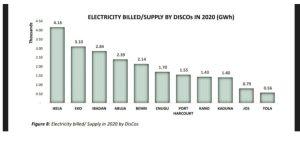
Source: National Bureau of Statistics (NBS), 2022.
Household Access to Electricity
Assessing household access to electricity in Ogun State requires a closer look at the data from IBEDC’s coverage area. In 2020, IBEDC had the highest number of estimated billing customers among DISCOs, with 1,282,136 customers. This figure provides insight into the number of households connected to the grid; however, it does not specify the percentage of households with access to electricity within Ogun State specifically.
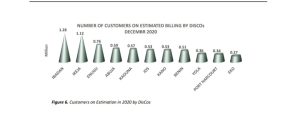
Source: National Bureau of Statistics (NBS), 2022.
Quality and Consistency of Power Supply
While connection to the grid is a critical metric, the quality and consistency of power supply are equally important. Nationally, Nigeria has faced challenges in providing stable electricity. For instance, in March 2021, the average electrical energy produced was sufficient to deliver only 189W (approximately three 60-watt bulbs) of power to each of Nigeria’s 24 million households with access to electricity. This statistic underscores the broader issues of energy insufficiency affecting households across the country, including those in Ogun State.
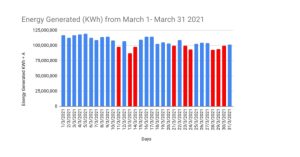
Source: Dataphyte, 2021
Implications of the 30MW Power Plant
The introduction of a 30MW power plant in Ogun State represents a significant enhancement to the state’s power infrastructure. To contextualize, Nigeria’s power generation capacity has historically been between 4,000 and 5,400 MW for a population exceeding 200 million. Adding 30MW locally could substantially improve the reliability and availability of electricity for Ogun State residents, potentially increasing the average daily supply duration for households.
In conclusion, Governor Abiodun’s inspection of the new 30MW power plant signifies a proactive approach to addressing the power supply challenges in Ogun State. While national statistics indicate ongoing struggles with electricity access and reliability, localized initiatives like this plant could bring the state closer to achieving the goal of 24-hour power supply for its residents.
778 total views, 2 views today

